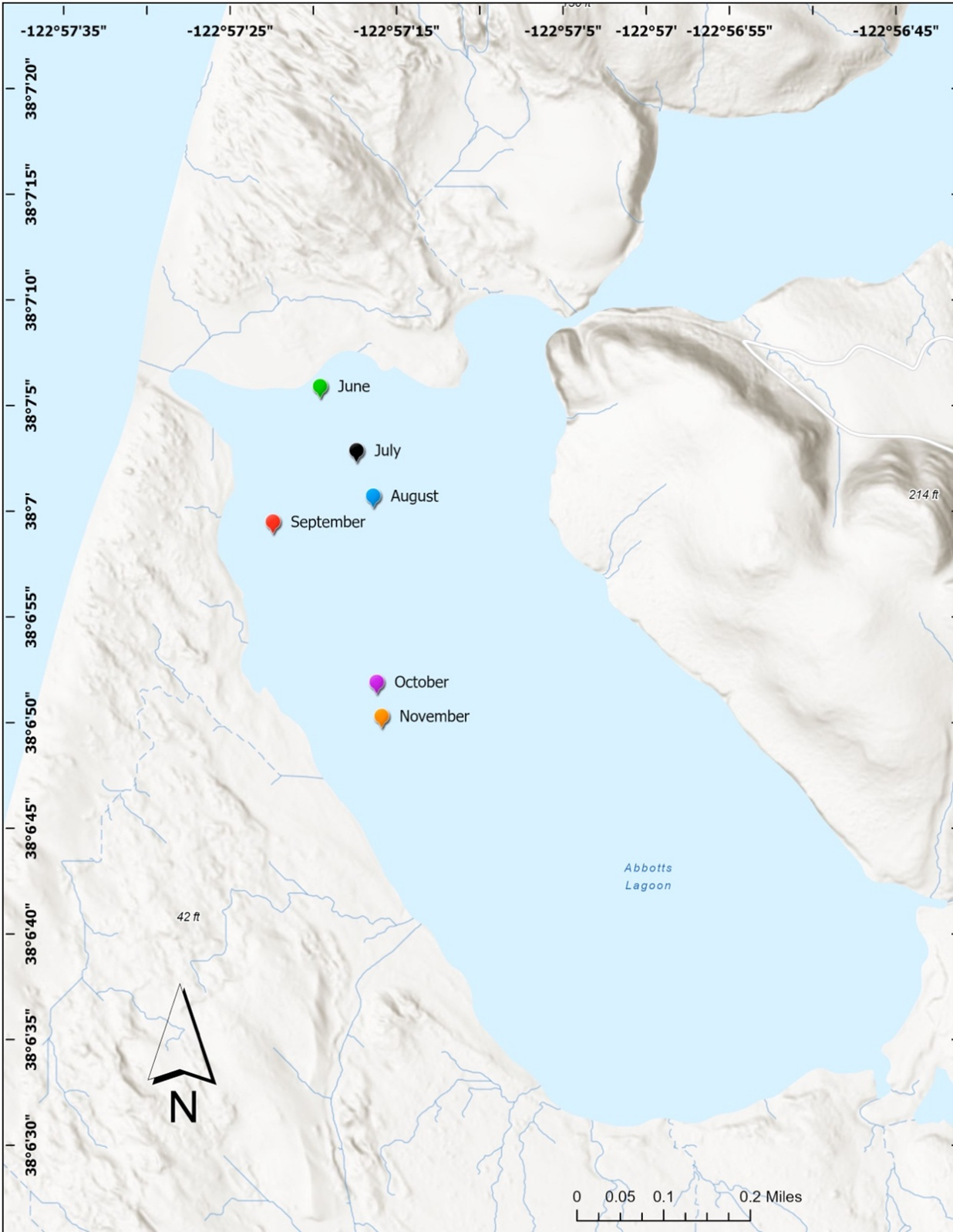IUCN/SSC Otter Specialist Group Bulletin

©IUCN/SCC Otter Specialist Group
Volume 42 Issue 2 (March 2025)
Citation: Carroll, T. and Isadore, M. (2025). North American River Otter (Lontra canadensis) Predation on Brown Pelicans (Pelecanus occidentalis) at Abbotts Lagoon, Point Reyes National Seashore, California, USA. IUCN Otter Spec. Group Bull. 42 (2): 71 - 84
North American River Otter (Lontra canadensis) Predation on Brown Pelicans (Pelecanus occidentalis) at Abbotts Lagoon, Point Reyes National Seashore, California, USA
Terence Carroll1,2* and Megan Isadore1,2
1River Otter Ecology Project, PO Box 103, Forest Knolls, CA 94933, USA
2IUCN/SSC Otter Specialist Group
*Corresponding Author Email: terence@riverotterecology.org
Received 14th November 2024, accepted 12th December 2024
Abstract: North American river otters (Lontra canadensis) are opportunistic predators whose diet preferences may have ecosystem effects. In Northern California, USA, river otters are a recovering species, and their diet commonly includes waterbirds. Beginning in 2018, we observed and documented river otter predation on Brown pelicans (Pelecanus occidentalis), a novel prey choice for river otters, at a coastal lagoon. To investigate this emerging predator-prey relationship, in 2023 we conducted repeated surveys from June through November to identify and document the carcasses of Brown pelicans that had been predated by river otters. In 19 surveys, we found 73 carcasses. Carcass counts on individual surveys ranged from 0 to 11, with a mean of 3.84 carcasses per survey. Comparing carcass counts to weekly average pelican abundance, as reported by eBird, we found a moderate correlation between the two. Based on the location of the largest grouping of pelicans we observed on each survey, we found no evidence that, in the aggregate, pelicans altered their pattern of use of the lagoon in response to predation. Spatial analysis of carcass distribution revealed no significant clustering, suggesting that predation occurred across different areas of the lagoon. This study sheds light on the dietary choices of river otters, and also highlights important ecological questions. Persistence of this predator-prey relationship may influence nutrient cycles, as pelican carcasses are a nutrient subsidy for local scavengers. Our findings underscore the need for further study into the long-term effects of river otter predation on pelican populations, and on broader ecosystem dynamics in coastal environments.
Keywords: predator-prey relationships; novel prey choice; nutrient subsidy; recovering species; coastal ecosystem dynamics
INTRODUCTION
North American river otters (Lontra canadensis) are opportunistic predators whose diet varies seasonally according to availability of prey species (Melquist et al., 2003), and whose diet choices can have ecosystem effects (Crait and Ben-David, 2006, 2007; Garwood, 2013). In parts of Northern California, USA, river otters are a recovering species (Schempf and White, 1977; Bouley et al., 2015), and their diet commonly includes various species of waterbirds (Penland and Black, 2009; Oates et al., 2019; Cosby and Szykman Gunther, 2021). Brown pelicans (Pelecanus occidentalis), marine-foraging seabirds that typically weigh approximately 3 to 4 kg and have a wingspan of over 2m (Schreiber et al., 1989), are also a recovering species, having been removed from Endangered Species Act protection in 2009 (USFWS, 2009; Jacques et al., 2016). Brown pelicans are present at Abbotts Lagoon (38°06'54.0"N 122°57'10.8"W), in Point Reyes National Seashore, California during the nonbreeding season, May to December, using the lower lagoon as a resting site.
Beginning in the fall of 2018, and continuing to the present time, River Otter Ecology Project (ROEP) has observed and documented evidence of river otter predation on Brown pelicans at Abbotts Lagoon. We have received observer reports both through our community-science “Otter Spotter” web portal (https://riverotterecology.org/otter-spotter-community-based-science/), and by emails directly from observers. Figure 1 shows examples of photographic evidence provided by observers. In addition, we personally observed a river otter attacking and drowning a Brown pelican at Abbotts Lagoon in October 2021. In September 2022, we personally observed a group of river otters feeding on a freshly-predated pelican carcass they had dragged to the shoreline of the lagoon.
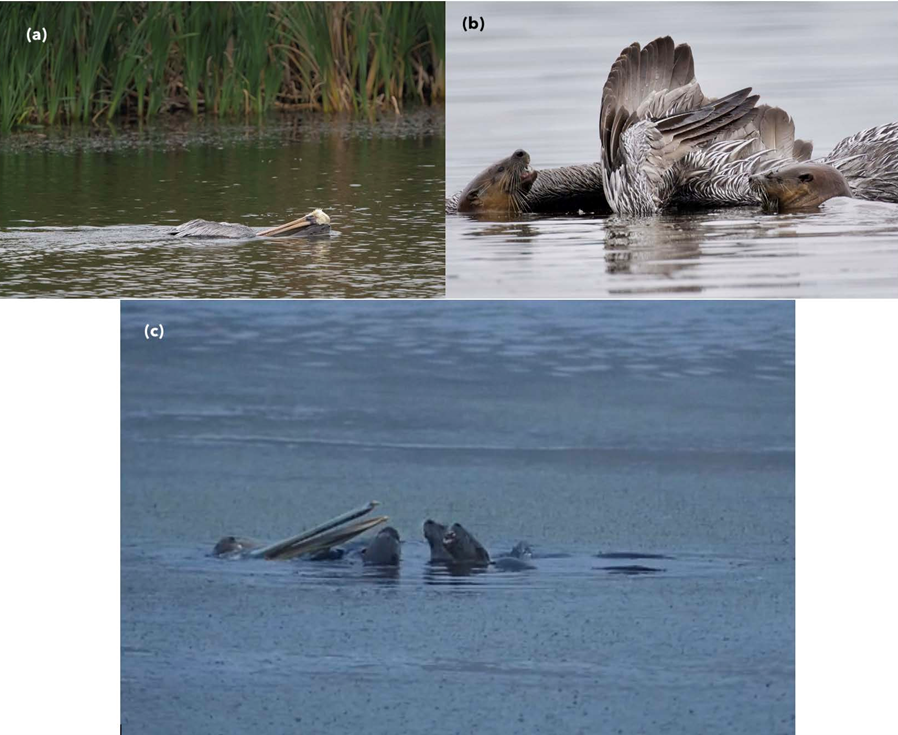
Brown pelicans are a novel prey choice for river otters. So far as is known, this predator-prey relationship only exists in California, and had only previously been observed and documented in 2006 at Rodeo Lagoon (37°49'51.4"N 122°31'55.9"W), 48 km southeast of Abbotts Lagoon, in the Golden Gate National Recreation Area, California (Salman, 2007), and in a single predation event in 1998 at Lake Tolowa (41°50'06.1"N 124°12'58.5"W), 429 km north of Abbotts Lagoon, in Del Norte County, California (D. Jaques, personal communication, November 30, 2023). Moreover, while conflict with California Sea Lions at commercial fishing docks, causing adult pelican injury or mortality, has been reported (Duerr et al., 2023), and there have been anecdotal accounts of sharks or eagles attacking them (D. Jaques, personal communication, November 30, 2023), adult Brown pelicans in California have no other known predators (Nevins et al., 2011; Stinson, 2014; Duerr et al., 2023).
At Abbotts Lagoon, river otters consume both fish and water birds year-round (Oates et al., 2019), and their predation of pelicans is likely an extension of an existing pattern of prey choice, rather than a response to changes in abundance of prey species, as hypothesized by Salman (2007) at Rodeo Lagoon. River otters are opportunistic predators, but their prey selection is heavily influenced by the energetic costs of foraging in aquatic environments, including thermoregulation costs (Kruuk, 2006). As a result, they tend to favor larger, less-agile prey species, and employ repetitive use of successful foraging routes (Blundell et al., 2001; Kruuk, 2006; Thompson and Stelle, 2014; Day et al., 2015.). In addition, river otters can gain a thermoregulatory advantage from catching larger prey that can be consumed on the shoreline (Kruuk, 2006), including pelicans.
At Rodeo Lagoon, Salman (2007) hypothesized that eutrophication had reduced fish stocks there, and that river otters began consuming pelicans as a supplemental or replacement food source. The same eutrophication condition does not exist presently at Abbotts Lagoon, and river otter predation on pelicans here likely represents a different relationship between predator and prey, and consequently may have different ecological and management implications. For example, river otters are providing a nutrient subsidy to local coyotes (Canis latrans) and other scavengers in the form of pelican carcasses (Gerraty et al., 2024). If pelicans are a consistent diet preference, rather than an episodic replacement food source, the ecosystem effects of these nutrient subsidies are likely to be magnified and longer-lasting.
Another important question, in terms of ecosystem recovery and function, is whether the pressure from river otter predation at Abbotts Lagoon is having a substantial localized negative impact on pelicans. The local persistence of this predator-prey relationship over a number of years suggests not. However, prior to our investigation, no baseline studies had been carried out to quantify the extent or impacts of this predation. We hypothesized that river otter predation of pelicans at Abbotts Lagoon occurs at a low level with little relation to the local abundance of pelicans. We further hypothesized that, in the aggregate, the pelicans have been tolerant of the predation, and do not respond to it by altering their pattern of use of the area, either spatially or over time.
STUDY AREA AND METHODS
Study Area
Abbotts Lagoon (38°06'54.0"N 122°57'10.8"W) is a complex of 3 connected lagoons on the coastal portion of the Point Reyes peninsula (Fig. 2). The lower lagoon is the largest and deepest of the 3, and is used by Brown pelicans as a resting place. The middle lagoon is separated from the lower lagoon by a rock outcropping, and is connected to it by a narrow channel spanned by a footbridge. The upper lagoon, the smallest of the 3, is fed by several small freshwater streams, and is separated from the middle lagoon by an earthen berm. For this study, we collected data at the lower lagoon, and along portions of the middle lagoon shoreline immediately adjacent to the footbridge.
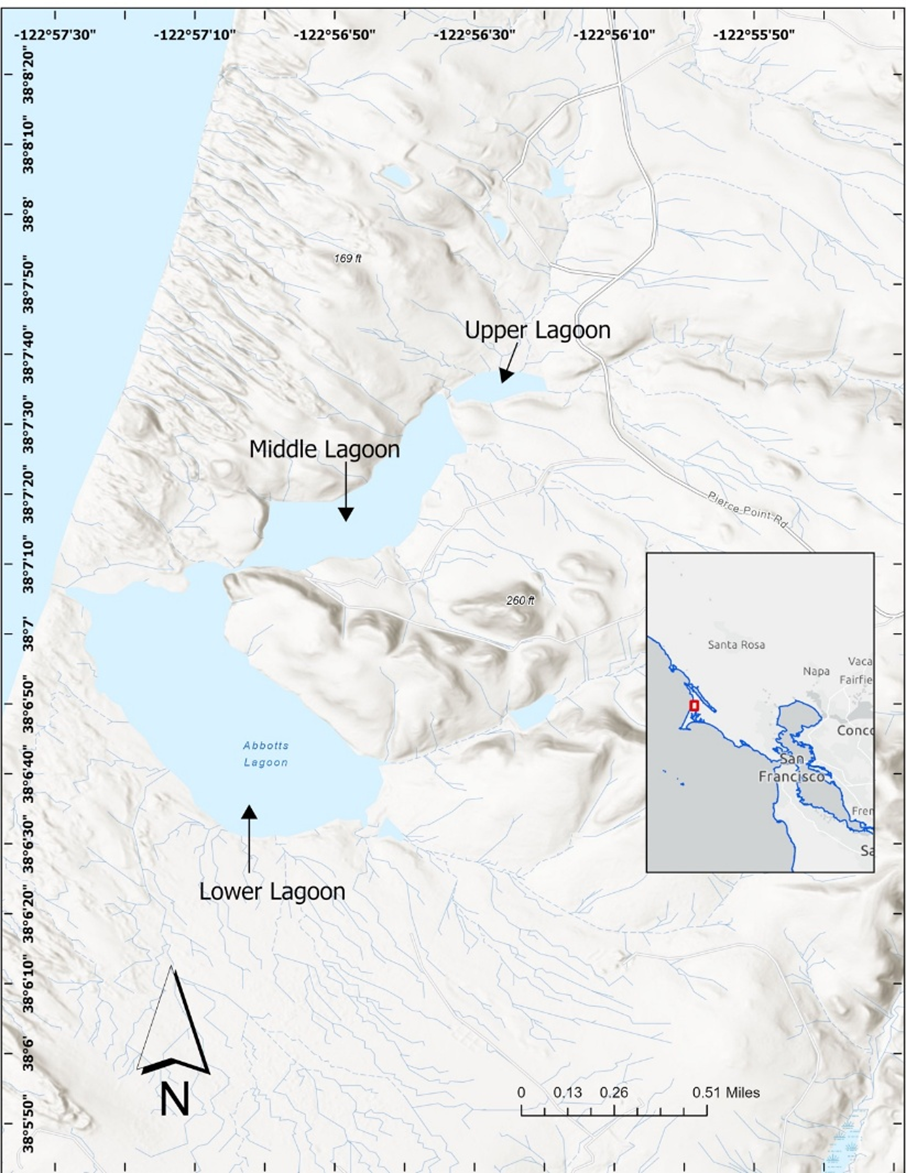
Identification of Predated Pelican Carcasses
Based on observational data, we found that in the course of feeding on predated pelican carcasses, river otters severed the head and neck from the body, likely to facilitate access to the flesh in the pelican’s breast area (see Fig. 3 for an example). With this understanding, we were able to identify pelican carcasses that likely had been predated by river otters (see Fig. 4 for examples).
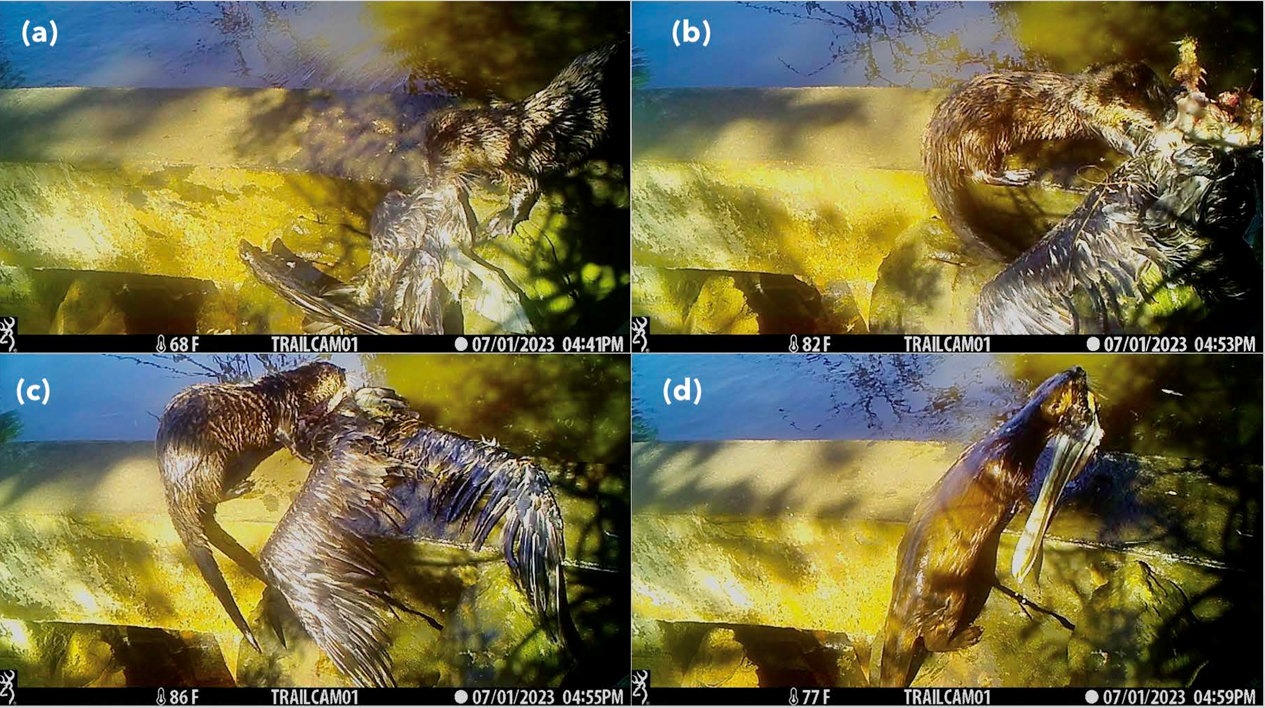
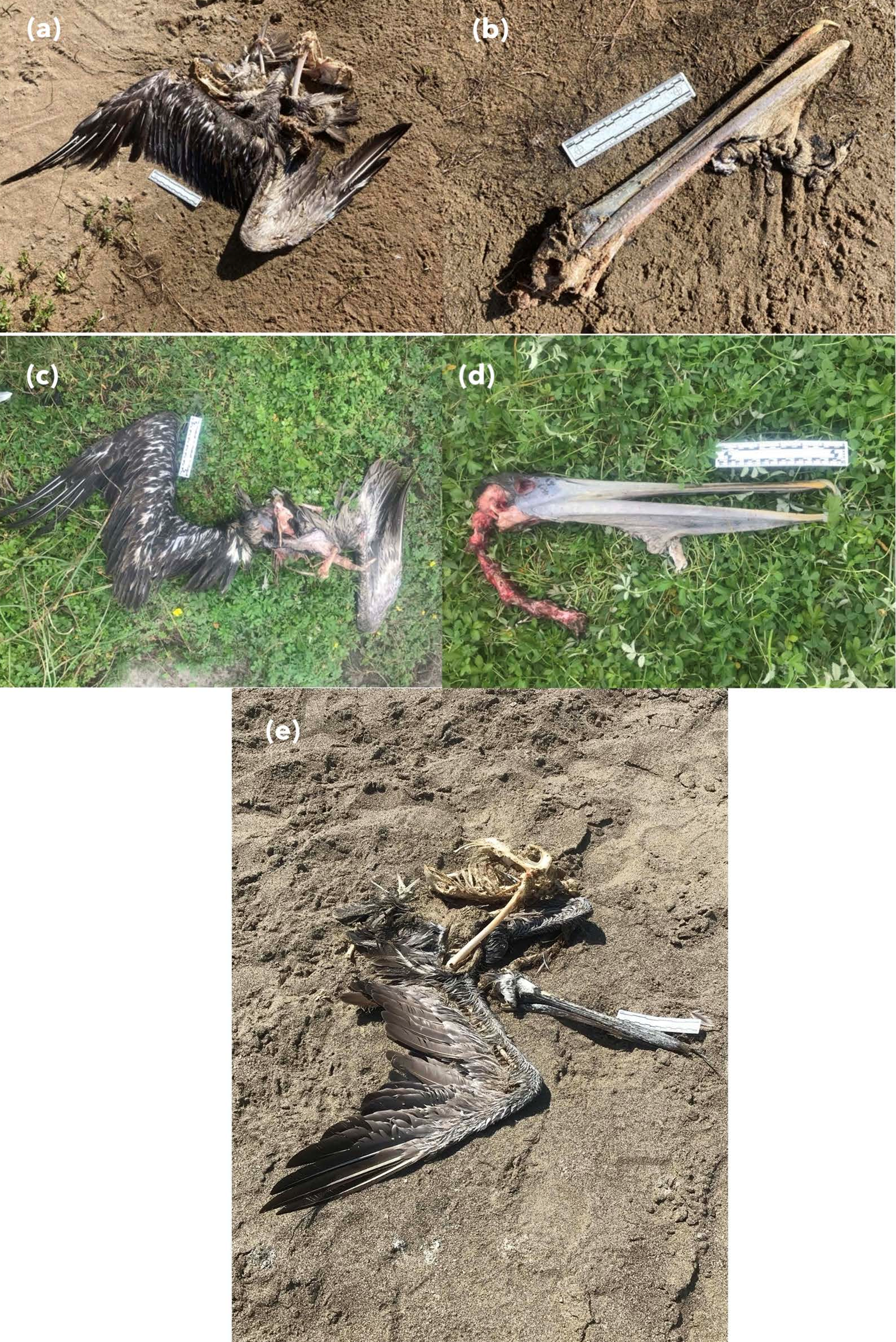
Carcass Data Collection
We established 4 survey areas along the perimeter of the lower lagoon and small portions of the middle lagoon near the footbridge (Fig. 5). From June through November 2023, we surveyed the perimeter of the lagoon approximately every 7 to 10 days. On each survey, we documented each predated pelican carcass we found, photographing it and mapping its location using Survey123 (ESRI, Redlands CA). To avoid double-counting, we used a fluorescent non-toxic permanent marking pen to mark the beak and larger bones of each documented carcass.
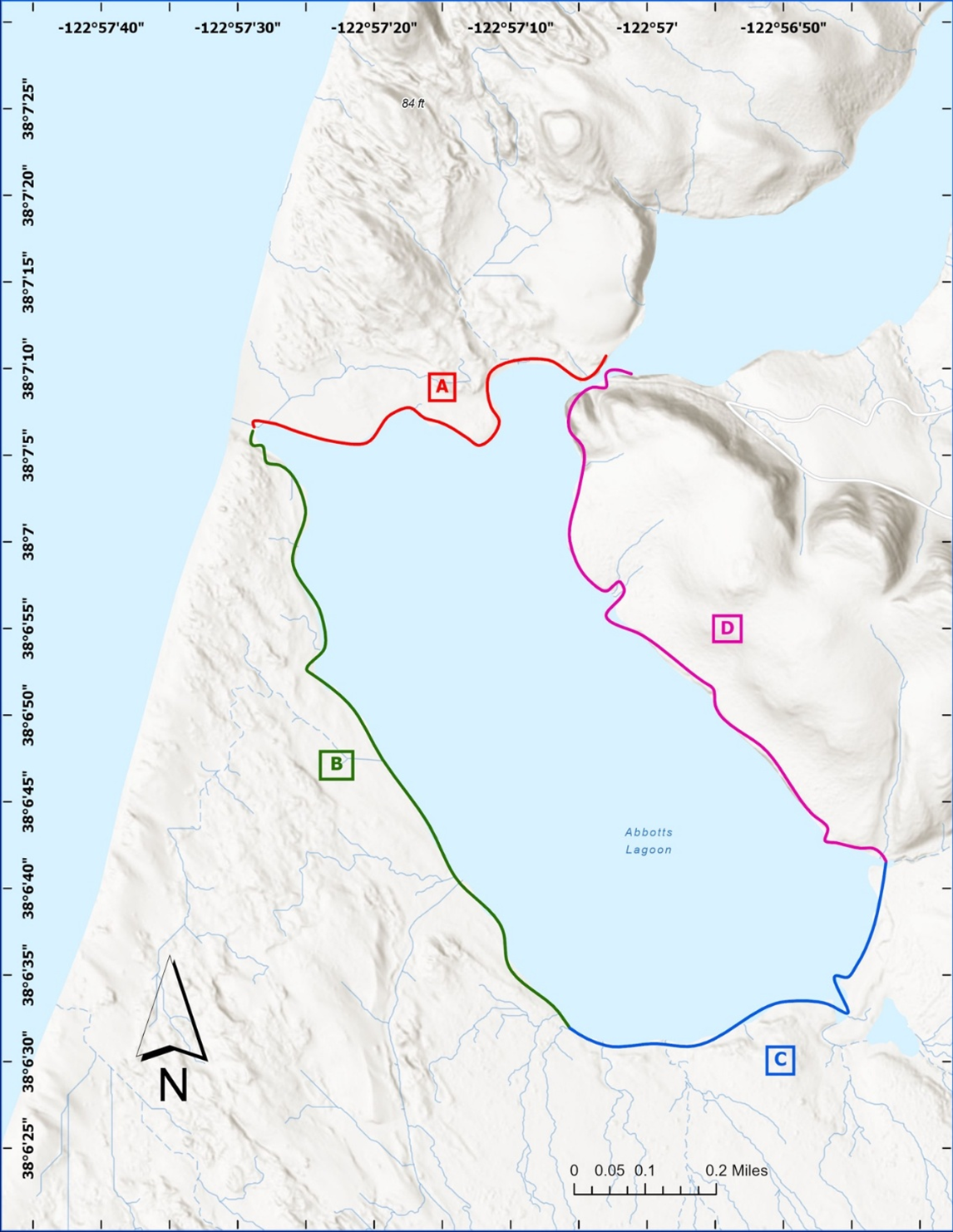
We assumed that carcasses found on the first survey were from pelicans predated prior to the study period, and did not include them in the data used for this study. In addition, from June through August, survey area B on the southwestern side of the lagoon was inaccessible due to a seasonal closure to protect nesting Western snowy plovers (Charadrius nivosus nivosus). Survey area C, at the southern end, was also inaccessible due to inundation of the area, and the need to reach it by crossing a stream that we determined was too wide and deep to safely ford. During June through August, therefore, on each survey we used binoculars or a spotting scope to scan areas B and C, and used Survey123 to record the locations of any suspected carcasses. During our first survey of areas B and C in September we verified or discounted the presence and location of those carcasses.
Pelican Presence and Abundance Data
On each survey, we used Survey123 to record our count of the number of resting pelicans present at the lagoon, and the approximate location of the largest grouping. As a proxy for pelican abundance, we used data from eBird [eBird, 2023]. Specifically, we used eBird’s Average Count data point for the week immediately preceding each survey date. Average Count represents the weekly average of the number of pelicans reported by observers who included Brown pelicans on a checklist of birds seen that they submitted for Abbotts Lagoon.
Data Analysis
For carcass data collected in survey areas B and C on our first survey in September, we matched carcasses found to the survey dates on which our visual scans first identified those suspected carcasses. For other carcasses found on in areas B and C on that survey, we used the condition of the carcass to estimate how long ago the pelican had been predated, and we accordingly assigned those carcasses to a survey date in July or August.
To assess the relationship, if any, between pelican abundance and predation by river otters, we used R version 4.3.3 (The R Foundation for Statistical Computing) to calculate the Spearman’s Rank Correlation between the eBird Average Count and our count of carcasses for each survey period. We considered a P-value <.05 to be significant.
To assess whether pelicans, in the aggregate, altered the spatial pattern of their use of the lagoon in response to predation, we mapped our observations of the largest groupings in ArcGIS Pro 3.1 (ESRI, Redlands CA). We then used ArcGIS Pro’s Mean Center function to determine the central point of those groupings for each month of the study period.
To assess whether the predation of pelicans was concentrated in particular areas of the lagoon, we used the ArcGIS Pro Optimized Hot Spot Analysis tool on the mapped locations of the carcasses. The tool performs a series of tests and operations on the spatial data to aggregate the points within the cells of a fishnet grid, and then produces a Getis-Ord Gi* statistic for each cell. The resulting z-scores and p-values describe the extent of the data’s spatial clustering. We considered a z-score greater than 1.96 and a P-value less than .05 to be significant.
RESULTS
Carcass Data Collection
During the study period we completed a total of 19 surveys. The first 10 surveys covered only Survey Areas A and D, with visual scanning of the opposite shoreline using binoculars or a spotting scope. The remaining 9 surveys covered the entire perimeter of the lower lagoon. Over the course of the surveys, we counted a total of 78 pelican carcasses, 73 of which we identified as having been predated by river otters during the study period. The other 5 were either too old or too fragmentary to allow for a conclusion that mortality occurred during the study period. Predated carcass counts on individual surveys ranged from a low of 0 to a high of 11 (![]() =3.84, SD= 3.24 ) (Table 1). The locations of the carcasses are shown in Figure 6.
=3.84, SD= 3.24 ) (Table 1). The locations of the carcasses are shown in Figure 6.
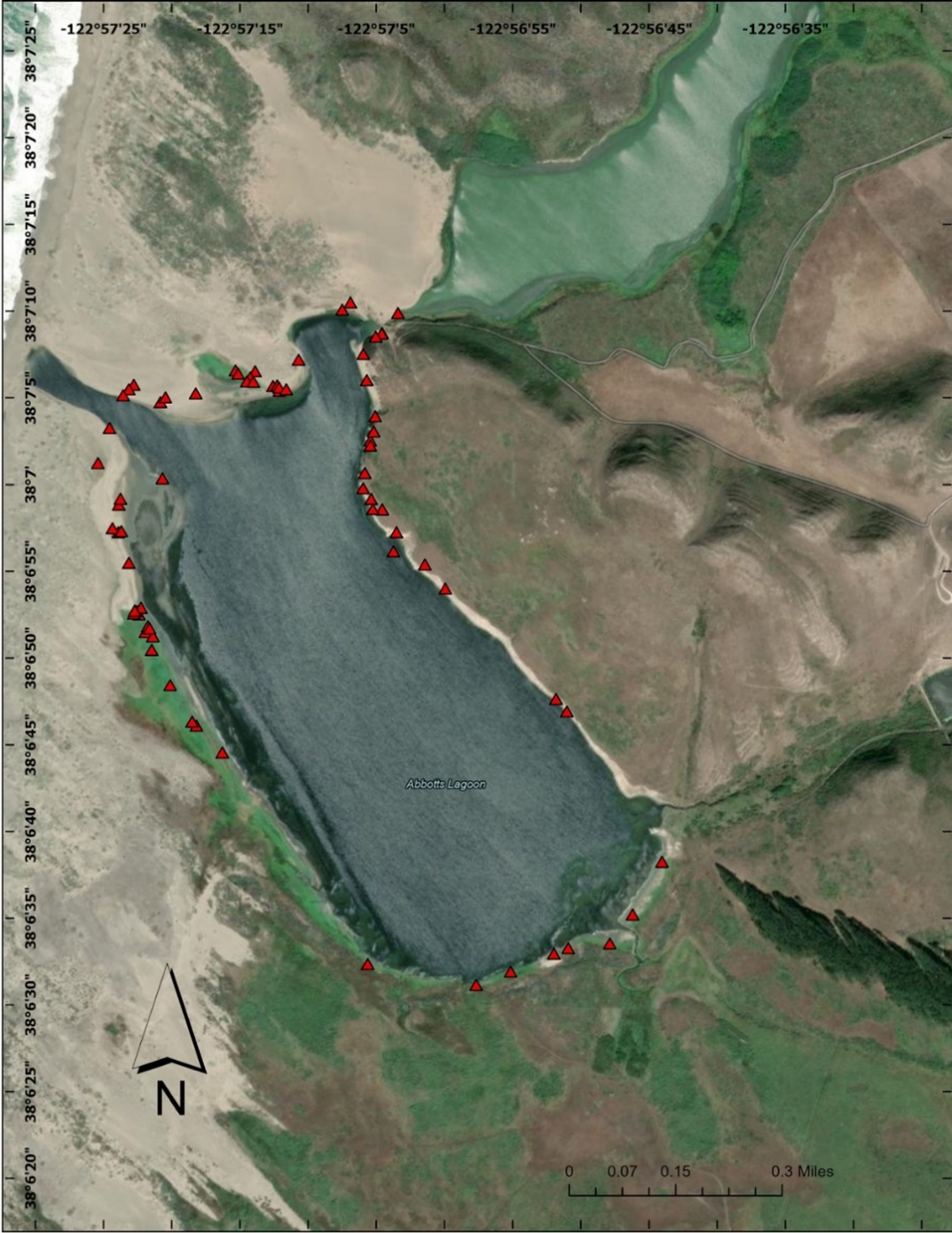
Pelican Presence and Abundance Data
Our counts of pelicans present on the lower lagoon ranged from a low of 0 to a high of 300 ( ![]() = 35.47, SD = 67.46). Weekly Average Counts from eBird ranged from a low of 5.20 to a high of 73.48 (
= 35.47, SD = 67.46). Weekly Average Counts from eBird ranged from a low of 5.20 to a high of 73.48 (![]() = 36.55, SD = 17.77) (Table 1).
= 36.55, SD = 17.77) (Table 1).
Data Analysis
The Spearman’s Rank Correlation between eBird Average Count and our count of carcasses for each survey period showed a moderate positive correlation between the two, with r(17) = .60, P=0.006. The spatial pattern of pelican use of the lagoon showed no apparent response to predation over time, with the monthly mean centers of pelican grouping all remaining in the northern half of the lagoon throughout the study period (Fig. 7).
The ArcGIS Pro Optimized Hot Spot Analysis Tool aggregated the carcass location points into 44 grid cells. From the calculation of the Getis-Ord Gi* for each cell, no z-scores exceeded 1.96, and all P-values were >0.05, indicating that the carcass locations were not significantly clustered in any part of the lagoon shoreline.
DISCUSSION
The weight of the evidence from our study strongly suggests that at Abbotts Lagoon, river otters are the sole predator of Brown pelicans, and our results indicate that this predation occurred on a consistent basis throughout the study period. On 17 of our 19 surveys, we found carcasses of pelicans that had been predated since the prior survey. In addition, the 73 carcasses we identified likely represent a conservative estimate of the true extent of predation levels. Given the inaccessibility of survey areas B and C until September, as well as the likelihood of scavengers carrying off carcasses between surveys, we assume that a number of carcasses went uncounted.
Contrary to our first hypothesis, we found a moderate correlation between pelican abundance at the lagoon and the level of predation by river otters. It may be that larger groupings of pelicans resting on the lagoon include more isolated individuals around the periphery of the group, facilitating predation by river otters. The apparent correlation may also be an artifact of our use of weekly abundance counts, rather than the actual number of pelicans present during a predation event. Alternatively, it could be particular to circumstances at the lagoon during the study period, including the number of river otters present. During our surveys, we observed and documented a total of 9 river otters, including 3 adult females and 6 pups. Further study over multiple years would be required to assess whether the apparent correlation persists, given variability in local river otter and Brown pelican abundance from year to year.
Consistent with our second hypothesis, we found no evidence that, in the aggregate, pelicans responded to predation by river otters by altering their pattern of use of the lagoon during the study period. As shown in Figure 7, the monthly mean center of pelican groupings moved generally southward over the course of the study period, but never moved south of latitude 38°06'54.0"N, roughly the middle latitude of the lower lagoon. No pelicans were observed south of that point at any time during our surveys. During the summer months, the surface area of the lower lagoon recedes due to evaporation, seepage, and diminished inflows (Kratzer et al., 2006). The southward movement of pelican groupings over time is consistent with movement to the deeper area of the lagoon. The persistence of the groupings in northern half of the lagoon suggests that, in the aggregate, pelicans are not moving to avoid predation.
Our analysis of the spatial distribution of pelican carcasses around the lower lagoon did not show significant clustering in any area. Any given location where we found the carcasses may not be indicative of predation occurring in close proximity. From observational reports and photographic evidence, we have documented that river otters sometimes tow or drag carcasses for some distance before consuming them. The presence of carcasses along the southern shoreline of the lower lagoon, where pelicans are unlikely to be present, also illustrates this dynamic.
Persistent predation of Brown pelicans by river otters is a novel phenomenon, and no similar studies exist to which to compare our results. Salman (2007) focused on frequency of occurrence of pelican remains in otter scat, and also incidentally reported finding 30 pelican carcasses at Rodeo Lagoon, but he collected data mainly in the months of October and the following March. Our research camera at Rodeo Lagoon (Carroll et al., 2020) captured video of rivers otters with a predated pelican in July 2023, but opportunistic surveys of the area did not reveal evidence of persistent widespread predation. The concurrent episodic predation there, and concurrent persistent predation at Abbotts Lagoon, presents a valuable research opportunity for studying this phenomenon in greater depth. Future research should include a study to determine the relative frequency of Brown pelicans as a prey item in river otter diet. A comparative study at the two lagoons could yield insight into the importance of Brown pelicans as a prey species for river otters, the local ecosystem effects of the predation, and the effects of predation on local Brown pelican populations.
Further study could also offer insight into Brown pelican behavior in the presence of a novel predator. Our results suggest that Brown pelicans have yet to develop behaviors to adapt to, or counteract, predation by river otters. However, on several subsequent opportunistic surveys during the late summer of 2024 we identified only 3 pelican carcasses along survey area A (Fig. 5), where there had been approximately 20 the at the same time in the prior year. These recent surveys suggest that the level of predation may have decreased. Further, during those surveys we observed a group of resting pelicans flush when a river otter approached. An observer at Rodeo Lagoon reported a similar interaction in August 2024. These observations are the first known reports of avoidance behavior on the part of Brown pelicans in the presence of river otters.
This study serves as a baseline from which to increase and enrich our understanding of an emerging predator-prey relationship between two recovering species in North-central California. Investigation of links among pelican habitat use, river otter predation behavior, and any consequent trophic subsidies may be a useful avenue for future research.
Acknowledgments - Funding for this study was provided by The Neubacher Fund for Marine Science at Point Reyes National Seashore, and by generous private donations to River Otter Ecology Project. We thank two anonymous reviewers for their very helpful comments. We are very grateful for the able assistance of A. Lipari-Maxson in collecting and recording the data used in the study. We gratefully acknowledge D. Jaques for sharing her expert knowledge of Brown pelicans. We also thank M. Lau, N. Warnock, and T. Gardali for their valuable suggestions and insight. Research was performed under River Otter Ecology Project’s current National Park Service permit #PORE-2021-SCI-0014.
REFERENCES
Blundell, G. M., Maier, J. A., and Debevec, E. M. (2001). Linear home ranges: effects of smoothing, sample size, and autocorrelation on kernel estimates. Ecol Monogr, 71(3), 469-489. https://doi.org/10.1890/0012-9615(2001)071[0469:LHREOS]2.0.CO;2
Bouley, P., Isadore, M., and Carroll, T. (2015). Return of North American River otters, Lontra canadensis, to coastal habitats of the San Francisco Bay Area, California. Northwestern Naturalist, 96(1), 1–12. https://doi.org/10.1898/NWN14-09.1
Carroll, T., Hellwig, E., and Isadore, M. (2020). An approach for long-term monitoring of recovering populations of nearctic river otters (Lontra canadensis) in the San Francisco Bay area, California. Northwestern Naturalist, 101(2), 77-91. https://doi.org/10.1898/1051-1733-101.2.77
Cosby, H. and Szykman Gunther, M. (2021). Variation in diet and activity of river otters (Lontra canadensis) by season and aquatic community. J Mammal, 102(2), 520–529. https://doi.org/10.1093/jmammal/gyaa165
Crait, J. R. and Ben-David, M. (2006). River otters in Yellowstone Lake depend on a declining cutthroat trout population. J Mamma, 87(3), 485-494. https://doi.org/10.1644/05-MAMM-A-205R1.1
Crait, J. R. and Ben-David, M. (2007). Effects of river otter activity on terrestrial plants in trophically altered Yellowstone Lake. Ecology, 88(4), 1040-1052. https://doi.org/10.1890/06-0078
Day, C. C., Westover, M. D., and McMillan, B. R. (2015). Seasonal diet of the northern river otter (Lontra canadensis): what drives prey selection?. C J of Zoolog, 93(3), 197-205. https://doi.org/10.1139/cjz-2014-0218
Duerr, R. S., Jaques, D. L., Selby, B. G., Skoglund, J. S., and Kosina, S. (2023). Medical History and Post-Release Survival of Rehabilitated California Brown Pelicans Pelecanus Occidentalis Californicus, 2009-2019. Marine Ornithology, 51(2), 157-168. http://www.marineornithology.org/PDF/51_2/51_2_157-168.pdf
eBird (2023). eBird: An online database of bird distribution and abundance [web application]. eBird, Cornell Lab of Ornithology, Ithaca, New York. Available at: http://www.ebird.org. (Accessed: December 2023).
Garwood J.M., Knapp R. A., Pope K.L., Grasso R.L., Magnuson M.L., and Maurer J.R. (2013). Use of historically fishless high-mountain lakes and streams by nearctic River Otters (Lontra canadensis) in California. Northwestern Naturalist 94(1), 51–66. https://doi.org/10.1898/12-12.1
Gerraty, F. D., Carroll, T., Williams, S., and Isadore, M. (2024). Recovering predators link aquatic and terrestrial ecosystems: River otters subsidize coyotes with carrion. Ecol Evol, 14(6), e11444. https://doi.org/10.1002/ece3.11444
Jaques, D. L. and Pacific Eco Logic. (2016). California Brown Pelican Monitoring Summary 2014 The Year of the Blob. US Fish & Wildlife Service, Ventura, CA. https://www.dfw.state.or.us/agency/commission/minutes/17/06_june/2014%20California%20Brown%20Pelican%20Monitoring%20Summary.pdf
Kratzer, C.R., Saleh, D.K., and Zamora, Celia (2006). Assessment of Hydrologic and Water Quality Data Collected in Abbotts Lagoon Watershed, Point Reyes National Seashore, California, during Water Years 1999 and 2000: U.S. Geological Survey Scientific Investigations Report 2005–5261, 35 pp. https://pubs.usgs.gov/sir/2005/5261/sir_2005-5261.pdf
Kruuk H. (2006). Otters: Ecology, behaviour and conservation. Oxford, UK: Oxford University Press. 265pp.
Melquist, W.E., P.J. Polechla, and D. Toweill. (2003). River otter (Lontra canadensis). pp. 708–734. In: Feldhamer, G.A., B.C. Thompson, and J.A. Chapman (Eds.). Wild Mammals of North America: Biology, Management, and Conservation. 2nd ed. The Johns Hopkins University Press, Baltimore, Maryland.
Nevins, H., Miller, M., Henkel, L., Jessup, D., Carion, N., Meteyer, C., Schuler, K., Leger, J.S., Woods, L., Skoglund, J., and Jaques, D. (2011). Summary of Unusual Stranding Events Affecting Brown Pelican Along the US Pacific Coast During Two Winters, 2008–2009 and 2009–2010. Marine Wildlife Veterinary Care and Research Center, Santa Cruz, CA. 30 pp. https://www.academia.edu/download/6090293/unusual_mortality_events_brown_pelicans.pdf
Oates, S., Isadore, M., and Carroll, T. (2019). Seasonal Food Habits of the North American River Otter (Lontra canadensis) in Point Reyes National Seashore and Peyton Slough Wetlands Complex, California. Technical Report. River Otter Ecology Project. 20pp. https://www.dropbox.com/scl/fi/sikh3zjj4vh07hr7387yp/Oates-et-al-2019-Seasonal-Food-Habits-of-the-North-American-River-Otter.pdf?rlkey=wcv6zdqqwmdz6ndgkoif1pac3&dl=0
Penland, T. F. and Black, J. M. (2009). Seasonal variation in river otter diet in coastal northern California. Northwestern Naturalist, 90(3), 233-237. https://www.jstor.org/stable/20628143
Salman, T. (2007). River Otter predation on Brown pelicans at a lagoon in the Golden Gate National Recreation Area. Report to the National Park Service. 11pp. https://nature.berkeley.edu/classes/es196/projects/2007final/Salman.pdf
Schempf, P. F. and White, M. (1977). Status of six furbearer populations in the mountains of northern California. San Francisco, CA: USDA Forest Service, California Region 5. 51 pp. https://books.google.com/books?hl=en&lr=&id=wxRnLNOSNmIC&oi=fnd&pg=PP4&ots=4pOVn5VohI&sig=XdqZIYzONvS6B2RE5PfMEzc5Icc#v=onepage&q&f=false
Schreiber, R. W., Schreiber, E. A., Anderson, D. W., and Bradley, D. W. (1989). Plumages and molts of Brown Pelicans. Contributions to Science, 402. 46pp. Natural History Museum of Los Angeles County. https://www.researchgate.net/profile/E-Schreiber-2/publication/339663295_Plumages_and_molts_of_brown_pelicans/links/5e5ed3f64585152ce804e5c6/Plumages-and-molts-of-brown-pelicans.pdf
Stinson, D. W. (2014). Draft periodic status review for the Brown Pelican. Washington Department of Fish and Wildlife, Olympia, Washington. 30 + iv pp. https://wdfw.wa.gov/sites/default/files/publications/01693/draft_wdfw01693.pdf
Thompson, L. and Stelle, L. L. (2014). Prey preference of the North American river otter (Lontra canadensis) evaluated based on optimal foraging theory. IUCN Otter Specialist Group Bulletin, 31(1), 15-29. https://www.iucnosgbull.org/Volume31/Thompson_Stelle_2014.html
U.S. Fish and Wildlife Service. ((2009). Draft post-delisting monitoring plan for the brown pelican. U.S. Fish and Wildlife Service, Ventura Fish and Wildlife Office, Ventura, California. 119pp. https://www.fws.gov/federal-register-file/draft-post-delisting-monitoring-plan-brown-pelican-pelecanus-occidentalis
Résumé: Prédation de Pélicans Bruns (Pelecanus occidentalis) par la Loutre de Rivière d'Amérique du Nord (Lontra canadensis) au Lagon d’Abbotts, Point Reyes National Seashore, Californie, États-Unis
Les loutres de rivière d’Amérique du Nord (Lontra canadensis) sont des prédateurs opportunistes dont les préférences alimentaires peuvent avoir des effets sur l’écosystème. Aux États-Unis dans le nord de la Californie, les loutres de rivière sont une espèce en voie de rétablissement et leur régime alimentaire comprend généralement des oiseaux aquatiques. À partir de 2018, nous avons observé et documenté la prédation des loutres de rivière sur les pélicans bruns (Pelecanus occidentalis), une nouvelle sélection de proie pour les loutres de rivière, dans une lagune côtière. Pour étudier cette relation proie-prédateur émergente, nous avons mené en 2023 des enquêtes répétées entre juin et novembre afin d’identifier et documenter les carcasses de pélicans bruns qui avaient été prédatées par les loutres de rivière. Lors de 19 enquêtes, nous avons trouvé 73 carcasses. Le nombre de carcasses lors des enquêtes individuelles variait entre 0 et 11, avec une moyenne de 3,84 carcasses par enquête. En comparant le nombre de carcasses à l’abondance moyenne hebdomadaire des pélicans, telle que rapportée par eBird, nous avons trouvé une corrélation modérée entre les deux. En nous basant sur la localisation du plus grand groupe de pélicans que nous avons observé lors de chaque étude, nous n’avons, dans l’ensemble, trouvé aucune preuve que les pélicans aient modifié leur mode d’utilisation du lagon en réponse à la prédation. L’analyse spatiale de la distribution des carcasses n’a révélé aucun regroupement significatif, ce qui suggère que la prédation s’est produite dans différentes zones du lagon. Cette étude met en lumière les choix alimentaires des loutres de rivière et met également en évidence d’importantes questions écologiques. La persistance de cette relation proie-prédateur peut influencer les cycles nutritifs, car les carcasses de pélicans constituent un apport complémentaire en nutriments pour les charognards locaux. Nos résultats soulignent la nécessité d’étudier plus en détail les effets à long terme de la prédation des loutres de rivière sur les populations de pélicans et sur la dynamique plus large des écosystèmes dans les environnements côtiers.
Revenez au dessus
Resumen: Predación sobre Pelícanos Marrones (Pelecanus occidentalis) por parte de Nutrias de Río Norteamericanas (Lontra canadensis) en la Laguna Abbotts, Costa Nacional Point Reyes, California, EEUU
Las Nutrias de río Norteamericanas (Lontra canadensis) son predadores oportunistas, cuyas preferencias dietarias pueden tener efectos ecosistémicos. En el Norte de California, EEUU, las nutrias son una especie en recuperación, y su dieta comúnmente incluye aves acuáticas. Comenzando en 2018, observamos y documentamos predación por parte de nutrias sobre Pelícanos Marrones (Pelecanus occidentalis), una elección de presas novedosa para las nutrias, en una laguna costera. Para investigar ésta relación predador-presa emergente, en 2023 condujimos relevamientos repetidos desde Junio hasta Noviembre para identificar y documentar las carcasas de pelícanos Marrones que habían sido predados por nutrias. En 19 relevamientos, encontramos 73 carcasas. Los conteos de carcasas en relevamientos individuales estuvieron entre 0 y 11, con una media de 3.84 carcasas por relevamiento. Comparando los conteos de carcasas con la abundancia semanal de pelícanos informada por eBird, encontramos una correlación moderada entre ambas variables. En base a la ubicación de los mayores agrupamientos de pelícanos que observamos en cada relevamiento, no encontramos evidencia de que, considerado en conjunto, los pelícanos alteraran sus patrones de uso de la laguna en respuesta a la predación. Este estudio arroja luz sobre las elecciones dietarias de las nutrias, y también destaca importantes preguntas ecológicas. La persistencia de ésta relación predador-presa puede influir en los ciclos de nutrientes, ya que las carcasas de pelícano son un subsidio nutricional para los carroñeros locales. Nuestros hallazgos subrayan la necesidad de realizar más estudios sobre los efectos a largo plazo de la predación de las nutrias sobre las poblaciones de pelícano, y sobre la dinámica ecosistémica más amplia en los ambientes costeros.
Vuelva a la tapa
